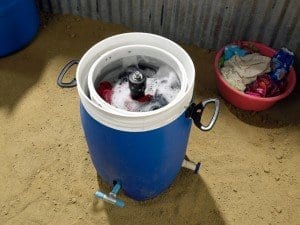
DEVELOPED BY TWO PRODUCT DESIGN STUDENTS, GIRADORA COULD BE THE NEXT BIG SOCIAL INNOVATION.
About a year ago, two design students named Alex Cabunoc and Ji A Youtraveled from their homes in Los Angeles to Cerro Verde, a 30,000 person slum outside of Lima. As students in the celebrated Design Mattersprogram at Art Center College of Design, which focuses on social innovation, they had come to Cerro Verde as part of a special studio calledSafe Agua Peru. Their goal? Develop a commercial product that alleviates issues related to water poverty, targeted at people who earn between $4 and $10 a day.
The students spent two weeks in Cerro Verde, working closely with inhabitants to prototype “co-created” products at a break-neck speed. Since returning, nearly half of the students have won International Design Excellence Awards, and a student-made documentary about the trip called Hands in the Mist has been shortlisted for a Young Directors Award at Cannes. Cabunoc and You’s design–a manually powered washer and dryer that costs less than $40 called GiraDora–has drawn special attention.
When they first arrived in the slum, the pair were shocked at the amount of time Cerro Verde’s inhabitants spent collecting the water needed to perform the most basic tasks. “So much time, energy, and resources are used for basic water chores like cooking and cleaning,” remembers Cabunoc. “It leaves little time for other activities that might help one get out of poverty.” In particular, washing clothes is a major timesuck–it can eat up as much as six hours a day. There are major physical challenges involved with doing a simple load of laundry, too: lugging heavy buckets of water from a clean site, for example, or finding a way to dry the clothes before they get moldy.
The duo knew they had uncovered a huge opportunity for innovation by design. Why didn’t a manually powered washer or dryer already exist? They got to work, building a series of study models based on salad spinners and other similar human-powered devices. But their first finished prototype–a spin dryer–didn’t quite hit the mark with Cerro Verde’s inhabitants, who countered with an idea for an ad-hoc combination washer and dryer. “They felt it added more value as one single product,” writes Cabunoc. “This radically changed our design direction.”
via FastCoDesign – KELSEY CAMPBELL-DOLLAGHAN
The Latest Streaming News: Foot-Powered Washing Machine updated minute-by-minute
Bookmark this page and come back often
Latest NEWS
Latest VIDEO
The Latest from the BLOGOSPHERE







